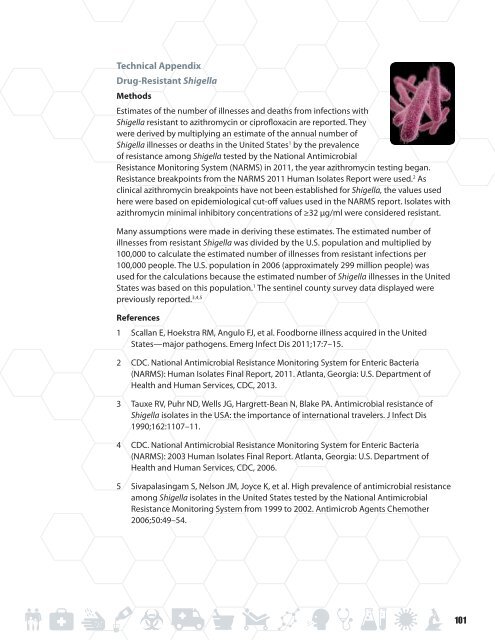Antibiotic Resistance Threats in the United States, 2013 report
Antibiotic Resistance Threats in the United States, 2013 report
Antibiotic Resistance Threats in the United States, 2013 report
Create successful ePaper yourself
Turn your PDF publications into a flip-book with our unique Google optimized e-Paper software.
Technical Appendix<br />
Drug-Resistant Shigella<br />
Methods<br />
Estimates of <strong>the</strong> number of illnesses and deaths from <strong>in</strong>fections with<br />
Shigella resistant to azithromyc<strong>in</strong> or ciprofloxac<strong>in</strong> are <strong>report</strong>ed. They<br />
were derived by multiply<strong>in</strong>g an estimate of <strong>the</strong> annual number of<br />
Shigella illnesses or deaths <strong>in</strong> <strong>the</strong> <strong>United</strong> <strong>States</strong> 1 by <strong>the</strong> prevalence<br />
of resistance among Shigella tested by <strong>the</strong> National Antimicrobial<br />
<strong>Resistance</strong> Monitor<strong>in</strong>g System (NARMS) <strong>in</strong> 2011, <strong>the</strong> year azithromyc<strong>in</strong> test<strong>in</strong>g began.<br />
<strong>Resistance</strong> breakpo<strong>in</strong>ts from <strong>the</strong> NARMS 2011 Human Isolates Report were used. 2 As<br />
cl<strong>in</strong>ical azithromyc<strong>in</strong> breakpo<strong>in</strong>ts have not been established for Shigella, <strong>the</strong> values used<br />
here were based on epidemiological cut-off values used <strong>in</strong> <strong>the</strong> NARMS <strong>report</strong>. Isolates with<br />
azithromyc<strong>in</strong> m<strong>in</strong>imal <strong>in</strong>hibitory concentrations of ≥32 µg/ml were considered resistant.<br />
Many assumptions were made <strong>in</strong> deriv<strong>in</strong>g <strong>the</strong>se estimates. The estimated number of<br />
illnesses from resistant Shigella was divided by <strong>the</strong> U.S. population and multiplied by<br />
100,000 to calculate <strong>the</strong> estimated number of illnesses from resistant <strong>in</strong>fections per<br />
100,000 people. The U.S. population <strong>in</strong> 2006 (approximately 299 million people) was<br />
used for <strong>the</strong> calculations because <strong>the</strong> estimated number of Shigella illnesses <strong>in</strong> <strong>the</strong> <strong>United</strong><br />
<strong>States</strong> was based on this population. 1 The sent<strong>in</strong>el county survey data displayed were<br />
previously <strong>report</strong>ed. 3,4,5<br />
References<br />
1 Scallan E, Hoekstra RM, Angulo FJ, et al. Foodborne illness acquired <strong>in</strong> <strong>the</strong> <strong>United</strong><br />
<strong>States</strong>—major pathogens. Emerg Infect Dis 2011;17:7–15.<br />
2 CDC. National Antimicrobial <strong>Resistance</strong> Monitor<strong>in</strong>g System for Enteric Bacteria<br />
(NARMS): Human Isolates F<strong>in</strong>al Report, 2011. Atlanta, Georgia: U.S. Department of<br />
Health and Human Services, CDC, <strong>2013</strong>.<br />
3 Tauxe RV, Puhr ND, Wells JG, Hargrett-Bean N, Blake PA. Antimicrobial resistance of<br />
Shigella isolates <strong>in</strong> <strong>the</strong> USA: <strong>the</strong> importance of <strong>in</strong>ternational travelers. J Infect Dis<br />
1990;162:1107–11.<br />
4 CDC. National Antimicrobial <strong>Resistance</strong> Monitor<strong>in</strong>g System for Enteric Bacteria<br />
(NARMS): 2003 Human Isolates F<strong>in</strong>al Report. Atlanta, Georgia: U.S. Department of<br />
Health and Human Services, CDC, 2006.<br />
5 Sivapalas<strong>in</strong>gam S, Nelson JM, Joyce K, et al. High prevalence of antimicrobial resistance<br />
among Shigella isolates <strong>in</strong> <strong>the</strong> <strong>United</strong> <strong>States</strong> tested by <strong>the</strong> National Antimicrobial<br />
<strong>Resistance</strong> Monitor<strong>in</strong>g System from 1999 to 2002. Antimicrob Agents Chemo<strong>the</strong>r<br />
2006;50:49–54.<br />
101
















